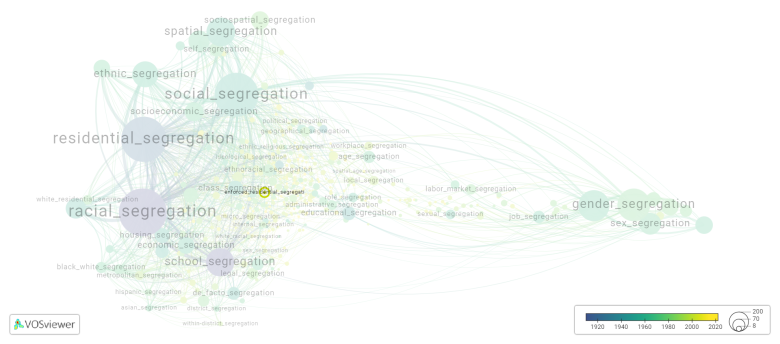Enforced residential segregation: Difference between revisions
(Creating page) |
(Creating page) |
||
| Line 18: | Line 18: | ||
[[File:enforced_residential_segregation.png|780x780px]] | [[File:enforced_residential_segregation.png|780x780px]] | ||
This visualization is based on the study [[ | This visualization is based on the study [[Segregation_Wiki:About| The Multidisciplinary Landscape of Segregation Research]]. | ||
For the complete network of interrelated segregation forms, please refer to: | For the complete network of interrelated segregation forms, please refer to: | ||
Latest revision as of 07:17, 16 October 2024
Date and country of first publication[1][edit | edit source]
2013
United States
Definition[edit | edit source]
Enforced residential segregation refers to policies or practices that deliberately separate different racial or ethnic groups into distinct residential areas, often with the intention of maintaining racial or social inequality.
Historically, enforced residential segregation has been prevalent in many countries around the world, including the United States during the era of racial segregation known as Jim Crow laws. These laws enforced separate housing accommodations for different racial groups, leading to the creation of racially divided neighborhoods and communities.
Enforced residential segregation can have several negative consequences. It perpetuates racial and social disparities by limiting access to quality housing, education, and jobs for marginalized groups. It can also contribute to the perpetuation of stereotypes and prejudices as people from different racial or ethnic backgrounds have limited interactions and opportunities to understand or appreciate each other's cultures.
Efforts to combat enforced residential segregation have been ongoing for decades. In the United States, for example, the Fair Housing Act of 1968 was enacted to prohibit housing discrimination based on race, color, religion, sex, national origin, and familial status. However, despite legal measures, residential segregation remains a persistent issue in many countries. Addressing and dismantling enforced residential segregation requires awareness, policy changes, and active efforts to foster inclusive communities that promote integration and equality.
See also[edit | edit source]
Related segregation forms[edit | edit source]
Enforced residential segregation is frequently discussed in the literature with the following segregation forms:
This visualization is based on the study The Multidisciplinary Landscape of Segregation Research.
For the complete network of interrelated segregation forms, please refer to:
References[edit | edit source]
Notes[edit | edit source]
- ↑ Date and country of first publication as informed by the Scopus database (December 2023).
At its current state, this definition has been generated by a Large Language Model (LLM) so far without review by an independent researcher or a member of the curating team of segregation experts that keep the Segregation Wiki online. While we strive for accuracy, we cannot guarantee its reliability, completeness and timeliness. Please use this content with caution and verify information as needed. Also, feel free to improve on the definition as you see fit, including the use of references and other informational resources. We value your input in enhancing the quality and accuracy of the definitions of segregation forms collectively offered in the Segregation Wiki ©.
Enforced residential segregation appears in the following literature[edit | edit source]
Hu-DeHart E. (2013). Chinatowns and borderlands: Inter Asian encounters in the diaspora. Sites of Asian Interaction: Ideas, Networks and Mobility, 191-215. Cambridge University Press.https://doi.org/10.1017/CBO9781139979474.011
McGrew T. (2018). The History of Residential Segregation in the United States, Title VIII, and the Homeownership Remedy. American Journal of Economics and Sociology, 77(3-4), 1013-1048. Blackwell Publishing Ltd.https://doi.org/10.1111/ajes.12243

